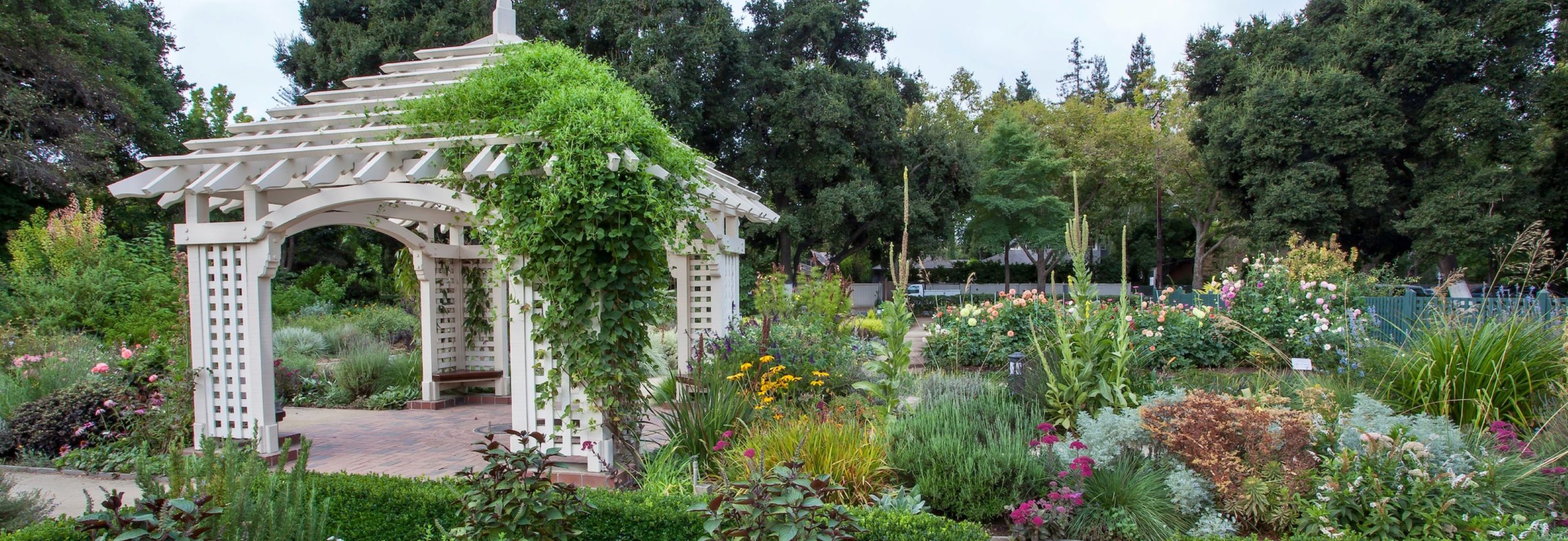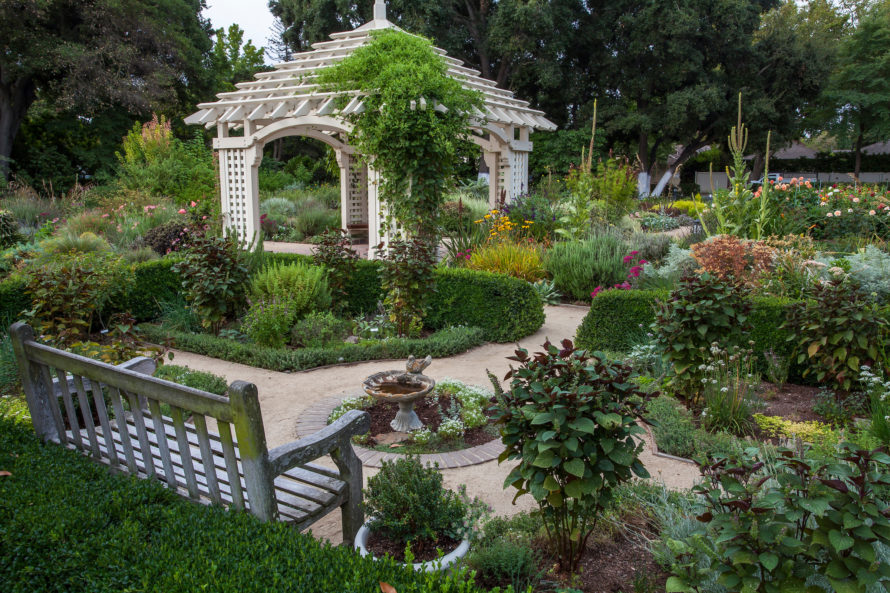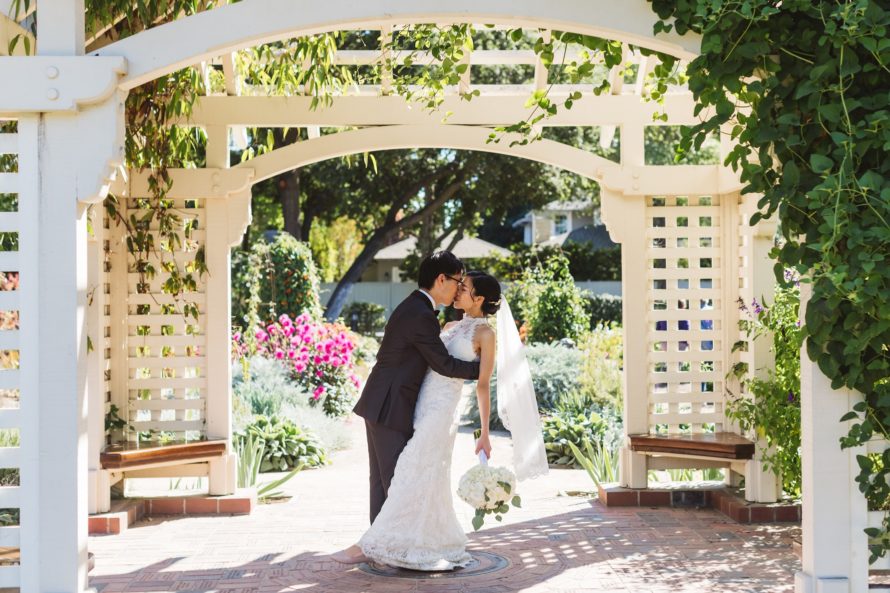The Gazebo, added in 1996, has become an iconic symbol for Gamble Garden and a Palo Alto landmark. It has been photographed for flyers, note cards, most of Gamble’s mailers, the website, the cover of books such as Landscape of Optimism, and a book whose theme was the most beautiful places to be married in the Bay Area.
A Gamble Icon
Construction
It would surprise many to learn that the gazebo was not completed until 1996, almost ten years after Gamble Garden was first developed as a public garden! Gamble’s initial development plan in 1987 included a pergola extending along the perennial border, all the way from the Waverley Street parking lot to the Tea House. Unfortunately, the proposed structure was deemed cost-prohibitive, and it was eliminated from the development plan.
The desire for a structure in the working garden remained, however, and efforts to revive the project began in the fall of 1993. Gamble turned to Bob Waterman, a local designer whose work had been the focal point in one of the gardens in Gamble’s Spring Tour. Bob was asked to design a structure to provide a vertical element to the perennial beds. His design borrowed elements from Craftsman and Japanese architecture, neatly tying in with existing structures around the property in a functional, artistic way.
Funding for the project was made possible by a grant from the Palo Alto Fund, contributions from generous donors, and existing capital. In early 1996, plans were submitted to the City of Palo Alto for review. After approval from the City, the Historic Resources Board and the Architectural Review Board, a building permit was obtained in May 1996.
Construction of various gazebo elements began in the summer of 1996. Gardenwood Design, a local wood shop, made detail cuts and fabricated the laminated curved arches. Because of the unusual dual hip rafter design, a large steel bracket was made to support the peak of the roof and provide anchorage for the hand-turned finial. Garden volunteer Jim Inglis, with the help of his wife, Ann, and Frank Goraj, hand-stained the pieces of wood with colors that matched the existing buildings on the property.
Assembly began in September 1996. A local contractor and master carpenter, Dan Corbo of Navajo Construction, was hired to help with the technical carpentry. Over a period of six weeks, the gazebo slowly took shape and became a reality. Once completed, the Garden Committee planted four vines, one on each corner of the gazebo, to serve as a visual enhancement and demonstration element for visitors: Sweet Autumn Clematis (Clematis terniflora), Chilean Jasmine (Mandevilla laxa), Climbing Fuchsia (Fuchsia regia var. alpestris) and White Bower Vine (Pandorea jasminoides ‘Alba’).
The Endowment Medallion and Endowment Bricks
Even as the gazebo was being constructed, plans were underway for a floor that would be just as magnificent and meaningful as the structure rising above it. A patterned brick floor was installed in 1997. It incorporates an ever-expanding collection of donor bricks representing major financial contributions to Gamble’s Endowment Fund. The brick endowment program began in 1996, with nine inital donors: The Garden Club of Palo Alto, Comerica Bank, Jean and Bob Gee, Walt and Mary McCullough, The Packard Foundation, Marde Ross, Maddy and Isac Stein, and Jane Stocklin.
The center of the brick floor was left untouched, leaving room for a raised bronze medallion which was completed in early 1998. Known as the Endowment Fund bronze medallion, it features a garden motif of leaves and flowers, surrounded by an engraved bronze ring with the words: The Elizabeth F. Gamble Garden Center, Est. 1985, Named Endowment Funds. The medallion was designed and created by David Von Kohorn of Von Kohorn and Kitzmiller (VKK) Signmakers, Inc., the design firm that created Gamble’s signage.
Today, the number of named bricks underneath the gazebo has grown from nine to one hundred and ninety-three, while the cost of a brick has grown from $7,500 to $10,000 today. Each brick bears the names of the donors or those whome they wish to honor, and each one is still engraved by VKK Signmakers (now a part of Priority Architectural Graphics, a leading San Francisco Bay Area architectural signage company). Moreover, each brick has a story, and each one represents the donor’s belief in Gamble Garden.
![]()
There are four perennial beds on each corner of the gazebo. Each bed has its own color scheme: warm pinks (coral, salmon, apricot, peach tones) with blues and lavenders in the bed closest to the edible garden, cool pinks (fuchsia, orchid, magenta) shading into lavender and blue in the bed closest to the Mediterranean beds, yellows, blues and purples in the bed closest to the herb garden and oranges, blues and purples in the bed closest to the cutting garden.
Plant List
The Bearded Iris was one of Miss Gamble’s favorite flowers. Gamble maintains an extensive collection of bearded irises, including Dykes Medal winners from 1928–1969. Prior to 2020, the Dykes Medal winners were located in their own bed. In the summer of 2020, they were relocated to the Perennial Beds near the gazebo to maintain their health and beauty. They now grow alongside other plants as part of the mixed border.
The only iris in the Perennial Beds not part of the Dykes medal collection is Gamble’s very own namesake, Iris ‘Elizabeth Gamble’. 1994, Lois O’Brien, a friend of Elizabeth Gamble, hybridized the blue ‘Elizabeth Gamble’ iris.
The previous irises growing in the Perennial Beds were relocated to the Salvia Bed, providing another spot of interest for that area.

Below is a partial list of plants (not including irises) in the four perennial beds surrounding the gazebo. The plant list is constantly changing; this list is current as of July 2022.
Alstroemeria ‘Regina’
Calibrachoa ‘Calibasket™ Corona’
Calibrachoa ‘Aloha Buttercream’
Crocosmia ‘George Davidson’
Dianella caerulea ‘DBB03’
Geum ‘Totally Tangerine’
Kniphofia rooperi
Salvia aurea
Salvia ‘Fancy Dancer’
Salvia x jamensis ‘Coral Sunrise’
Salvia x jamensis ‘Caviar’
Scabiosa ‘Pink Mist’
Sedum spectabile ‘Autumn Fire’
Sisyrinchium palmifolium
Sisyrinchium striatum
Stachys byzantina ‘Silver Carpet’
Heuchera ‘Leuchtkafer’
Heuchera hybrida ‘Kirella™ Fresh Green’
Hemerocallis ‘Coming Up Roses’
Hylotelephium ‘Thunderhead’
Muhlenbergia capillaris
Neomarica caerulea
Nemesia ‘Kirine 4’
Phorium ‘Maori Queen’
Platycodon grandiflorum
Pulsatilla vulgaris
Digitalis x valinii ‘TMDG1204’
Digitalis x valinii ‘Berry Canary’







